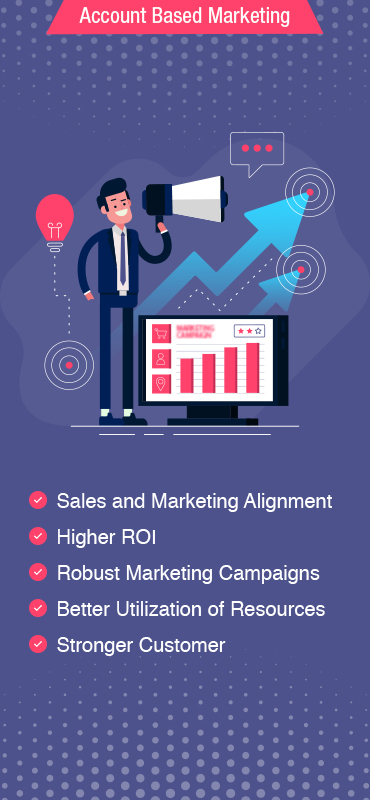“Earn trust, earn trust, earn trust. Then you can worry about the rest.” — Seth Godin.
Today’s competitive space demands trust and meaningful engagement to drive successful marketing. That’s why best-in-class companies are shifting their focus toward Account-Based Marketing (ABM).
According to HubSpot’s Not Another State of Marketing Report, 70% of marketers now have an active ABM program. This rise in adoption highlights the growing recognition of ABM’s effectiveness. A well-crafted ABM strategy, rooted in a brand’s core values, maximizes ROI by driving highly targeted engagement and meaningful conversions.
In this blog post, we’ll discuss how businesses can leverage Account-Based Marketing to drive targeted engagement and strengthen customer relationships.

The Building Blocks of a Successful Account-Based Marketing (ABM) Campaign Strategy
Listed below are steps to run a successful Account-Based Marketing campaign:
Step 1: Identify Target Accounts
A generic, one-size-fits-all approach rarely drives meaningful engagement. That’s why identifying target accounts is the foundation of a successful Account-Based Marketing (ABM) campaign. Choosing accounts at random can lead to wasted resources and missed opportunities. Instead, take a data-driven approach:
- Select target accounts based on industry verticals, business size, market fit, and the personas involved in decision-making.
- Leverage firmographics, business intelligence, and company credibility to refine your list strategically.
- Identify Marketing Qualified Leads (MQLs) to ensure your ABM campaign focuses on the most promising opportunities.
Step 2: Build Account-Specific Profiles
Once target accounts are identified, the next step in your ABM campaign is to build detailed account-specific profiles. Understanding the key players within these accounts and tailoring engagement strategies accordingly ensures effective personalized marketing.
Key Steps to Build Account-Specific Profiles:
- Map Leads to Accounts: ABM isn’t about reaching just one contact, it’s about influencing multiple decision-makers within an account. Leverage internal CRM data and external databases to map leads to accounts, identifying key influencers and stakeholders.
- Create Account-Relevant Content: A generic approach won’t drive engagement. Develop highly personalized marketing content tailored to business challenges, goals, and top initiatives of each target account.
- Align Content to Business Priorities: Your messaging should directly address pain points, market trends, and growth opportunities relevant to each account, helping accelerate marketing funnel velocity.
By building well-researched profiles, ensure that your re-targeting strategy resonates with the right decision-makers, increasing the likelihood of conversions.
Here’s an example of a persona:

Step 3: Execute Well-Targeted & Coordinated Campaigns
Driving marketing funnel velocity is a top priority in any ABM campaign, making it essential to deliver the right content at the right time. A well-executed, coordinated campaign ensures seamless engagement across multiple touchpoints, accelerating decision-makers through the funnel.
Key Execution Strategies:
- Personalized Outreach: Leverage personalized marketing through human emails, tailored messages, and voicemails to establish meaningful connections with key stakeholders.
- Multi-Channel Engagement: Implement a re-targeting strategy across diverse channels, including website personalization, targeted ads, and live events to reinforce messaging at every stage.
- Consistent Messaging: Ensure that all communications—whether on your website, emails, or social media—are aligned, creating a cohesive brand experience across target accounts.
Step 4: Re-Targeting – An Influential Conversion Strategy
Re-targeting is a key tactic in an Account-Based Marketing (ABM) campaign that enables brands to re-engage potential customers who have previously shown interest but didn’t convert. By strategically displaying personalized marketing messages to bounced-back traffic, businesses can improve conversion rates while optimizing ad spend.
Why Re-targeting Works:
- Focuses resources on prospects already familiar with your brand, increasing the likelihood of conversion.
- Reinforces brand recall through targeted ads across various digital channels.
- Enhances engagement by delivering relevant content based on past interactions.
Step 5: Optimize Results
ABM is a dynamic approach that requires ongoing analysis and optimization to drive success. From identifying target accounts to closing deals, each campaign phase should be measured and refined.
Key Optimization Metrics:
- Marketing funnel velocity: Assess how quickly accounts move from awareness to conversion.
- Value of contacts: Evaluate lead quality within target accounts to focus on high-potential opportunities.
- Conversion & retention rates: Measure the effectiveness of engagement strategies.
- Resource allocation: Distinguish between underperforming and high-performing assets to maximize ROI.
Related: Select the Right ABM Platform for B2B
Winning with ABM: Success Stories from Top Brands
- PayScale: PayScale, a digital compensation data and software provider, leveraged ABM to refine its marketing efforts and accelerate growth. By focusing on highly targeted accounts, they achieved a 500% increase in target account traffic and a 6x ROI increase in revenue within just seven months.[i]
- Snowflake: The cloud data platform Snowflake implemented an ABM strategy to engage high-value enterprise customers. By aligning sales and marketing teams, they saw a 300% increase in engagement rates from target accounts.[ii] Their success was driven by account-based advertising, personalized outreach, and data-driven insights.
- Adobe: Aimed to boost adoption of its Experience Cloud among large enterprises. By leveraging an ABM platform, Adobe gathered data on account activity to personalize engagement. The sales and marketing teams collaborated to create hyper-relevant messaging, resulting in increased demo requests from CMO-level executives and enhanced brand credibility among enterprise marketers.
- Siemens: This company targeted specific high-value accounts within the energy sector. By developing personalized marketing campaigns that addressed the unique needs of each target account, Siemens successfully deepened relationships with key stakeholders, leading to significant business growth in targeted segments.
Related Read: The Synergy of Account-Based Marketing and Marketing Automation
To Conclude
Account-Based Marketing (ABM) is the future of B2B marketing. As businesses seek higher engagement, better conversion rates, and stronger customer relationships, ABM stands out as the key to success. At Grazitti Interactive, we specialize in crafting data-driven ABM campaigns that align marketing and sales for maximum impact. Whether you’re looking to enhance targeting, personalize engagement, or drive revenue growth, our experts will guide you throughout the process.
Generate Quality Leads and Boost Customer Relationships with Robust ABM Campaigns. Discuss Your Project.
References:
[i] Martech Alliance
[ii] Orange Owl
Frequently Asked Questions (FAQs)
Ques 1: What is Account-Based Marketing, and how does it work?
Ans: Account-Based Marketing (ABM) is a strategic approach where sales and marketing teams collaborate to engage high-value target accounts with personalized marketing campaigns. By leveraging platforms like Marketo, HubSpot, and Microsoft Dynamics 365, businesses create tailored messaging, optimize engagement, and improve marketing funnel velocity to drive conversions.
Ques 2: How do I identify target accounts for an ABM campaign?
Ans: Identifying target accounts involves analyzing firmographics, intent data, and engagement metrics using tools like 6sense and LinkedIn Sales Navigator. AI-driven insights from CRMs can also help prioritize accounts that align with business goals, ensuring effective ABM campaign execution.
Ques 3: Why is retargeting important in ABM campaigns?
Ans: A strong re-targeting strategy keeps key decision-makers engaged throughout the ABM campaign. Using AI-driven tools and platforms like Marketo, businesses can serve dynamic ads, emails, and content to nurture prospects, improve marketing funnel velocity, and increase conversion rates.
Ques 4: What metrics should I track to measure the success of an ABM campaign?
Ans: Key ABM metrics include pipeline velocity, deal size, conversion rates, and customer lifetime value. Tracking engagement levels within target accounts, ad performance, and influenced revenue ensures campaign effectiveness. Integrating data from Microsoft Dynamics 365 and HubSpot also helps refine strategies for better results.
Ques 5: How can marketing automation tools like Marketo help in running ABM campaigns?
Ans: Marketo automates lead nurturing, segmentation, and engagement for ABM campaigns, delivering personalized marketing at scale. It also enhances re-targeting strategies, boosts marketing funnel velocity, and integrates with CRMs like Microsoft Dynamics 365, ensuring seamless execution and improved ROI.













